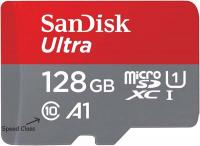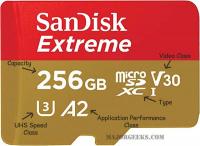The Differences in microSD Cards and How to Choose One for Your Device
By Corporal Punishmenton 06/21/2023 |
 Hey Geeks!
Hey Geeks! Recently I purchased a drone that required a MicroSD card for storage. I figure no big deal; I'll grab a card. However, while shopping noticed that there are different types of micro sd cards in the market, such as microSD, microSDHC, microSDXC, and microSDUC. Frankly, it had been some time since I needed to purchase a MicroSD Card, and I had no idea what those letters meant, and since I had to do the research, you get to read this. Thank me later.
The type is the first thing to look at when specking out the differences between microSD cards. The main difference among these types is the storage capacity. Here is a quick overview:
microSD: has a capacity of up to 2GB and works in any micro sd slot.
microSDHC: has a capacity of more than 2GB and up to 32GB and works in hardware that supports either SDHC and SDXC. (Secure Digital High Capacity)
microSDXC: has a capacity of more than 32GB and up to 2TB and works in hardware that supports SDXC. (Secure Digital Extended Capacity)
microSDUC: has a capacity of more than 2TB and up to 128TB and works in hardware that supports SDUC. (Secure Digital Ultra Capacity)
As you can see, the newer the standard, the higher the capacity. However, you may also have noticed that not all devices can use all types of cards. For example, if you have an older device that only supports microSD, you cannot use a microSDHC or higher card in that device. However, if you have a newer device that takes microSDUC, it is likely backward compatible with the other types. So be sure to check the specifications in your manual before buying a card.
Another difference among MicroSD cards is the speed class. Class speed indicates how fast the card can read and write data. A higher speed class is essential for applications requiring high-speed data transfer, such as video recording, gaming, or photography but less critical for data backing up. The speed class is marked on the card with a number inside a letter.
Speed Class: Denoted with a "C" symbol. (First class ever used)
Class 2: minimum speed of 2 MB/s
Class 4: minimum speed of 4 MB/s
Class 6: minimum speed of 6 MB/s
Class 10: minimum speed of 10 MB/s
UHS Speed Class: Denoted with a "U" Symbol
U1: minimum speed of 10 MB/s
U3: minimum speed of 30 MB/s
Video Speed Class: Denoted with a "V" Symbol
V6: minimum speed of 6 MB/s
V10: minimum speed of 10 MB/s
V30: minimum speed of 30 MB/s
V60: minimum speed of 60 MB/s
V90: minimum speed of 90 MB/s
Again, The higher the speed class, the better the performance. For example, if you want to record 4K video with your camera, you need a card that has at least U3 or V30 speed class. 4K Video will likely need a V90 class card. Otherwise, you may experience lagging or corrupted files. However, not all devices can support all speed classes. You should be fine; for example, your old GoPro is a U1, and you purchased a U3 - just the device will not fulfill the card's potential. Again, check the requirements of your device before buying a card.
You may also see an A number listed on your card. This number indicates Application Performance Class. There are currently only two ratings for this class. Either A1 or A2. There are two ratings for the App Performance Class, which are known as A1 and A2. A1 has a minimum random read of 1500 IOPS (input/output operations per second) and a minimum random write of 500 IOPS. A2 is rated for a minimum random read of 4000 IOPS and a minimum random write of 2000 IOPS. Suffice it to say that A2 cards are superior.


How do you choose the proper microSD card for your device?
Here are some tips:
1. Check the compatibility of your device with different types and speed classes of cards before purchasing. If a device uses a card, it usually comes with a card, so you can check the markings to decide on an upgrade. Otherwise, check the manual or Google.
2. Choose a card that has enough capacity for your needs. Remember that larger capacity cards are more expensive and may not work with older devices. (Refer to item 1.)
3. Choose a card with a high enough speed class for your applications. Again, remember that higher-speed classes are more expensive and may need to be compatible with your device. (Refer to Item 1.)
4. Quality is important with it comes to memory cards. So when shopping for a new card, stick to reputable brands offering a warranty or return policy. Sandisk, Samsung, Gigastone, Lexar, and Amazon Basic are brands I have used in the past with good results.
Hopefully, this took some of the mystery out of microSD card labeling, and you now have a better understanding of the differences in microSD cards and how to choose one for your needs. If you have any questions or comments, feel free to leave them below.
comments powered by Disqus





